HDMI Forum: Certification Program for Ultra High Speed HDMI 48G Incoming
by Anton Shilov on June 13, 2019 11:00 AM EST- Posted in
- Monitors
- Displays
- HDMI
- Trade Shows
- UHD
- HDR
- HDMI 2.1
- Computex 2019
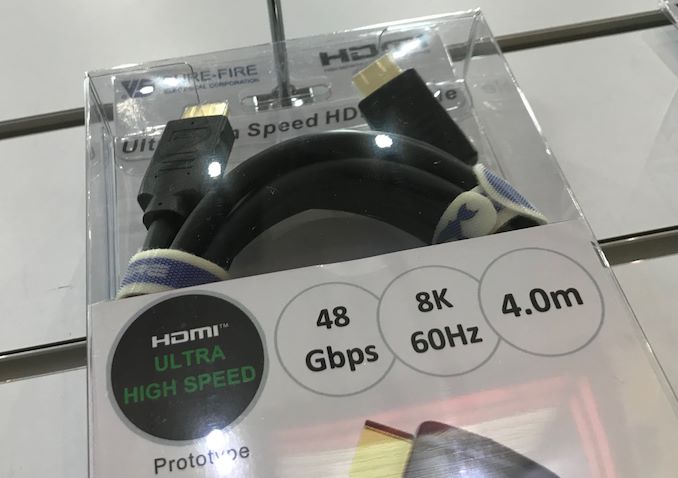
While the first HDMI 2.1 48G-branded cables were announced back in late 2018, they were not formally certified by the HDMI Forum for one reason: the certification program for HDMI 2.1 was not ready then and it is still not ready now. Yet, numerous developers of cables are already demonstrating prototypes of their HDMI 48G products that are marked as Ultra High Speed HDMI. Furthermore, makers of televisions are prepping the first Ultra-HD TVs that use HDMI 2.1.
UHS HDMI Certification Program
HDMI 2.1 48G cables use four data lanes operating at 12 Gbps each for an aggregate bandwidth of 48 Gbps, up from 18 Gbps today, yet retaining backwards compatibility with existing equipment. The additional bandwidth HDMI 2.1 offers enables it to support new Ultra-HD resolutions and refresh rates including, including 4Kp120, 8Kp100/120, 10Kp100/120, and upcoming color spaces, such as BT.2020 (Rec. 2020) with 10, 12, or even more advanced with 16 bits per color component. Actually, high resolutions and bit depths eat up 48 Gbps of bandwidth quickly, so for anything higher than 8Kp60 with 4:2:0 chroma sub sampling and 10-bit color, VESA’s DSC 1.2a link compression technology is used.
Since HDMI 2.1 48G cables as well as sources and sinks are physically different from existing HDMI 1.4/2.0 cables, makers of appropriate products have to adopt new manufacturing methods, whereas HDMI Forum has to introduce a new certification program that includes various compliance tests that ensure that interconnections work fine at high data rates and support all the features. Makers of cables are typically experienced enough to build HDMI 2.1 48G products, HDMI Forum admits. Since however there is no HDMI 2.1 48G certification program, they are not advised to sell products marked as Ultra High Speed HDMI Cables.
The HDMI Forum plans to make its UHS HDMI interconnection certification program available in the next several months, so expect ‘official’ HDMI 48G copper and optical cables to become available in the foreseeable future. Furthermore, once compliance tests are ready, makers of TVs will be able to mark their TVs as HDMI 2.1 compatible.
In addition to new resolutions, refresh rates, and HDR bit depths, HDMI 2.1 offers numerous new features, including Variable Refresh Rate (VRR), Quick Media Switching (QMS), Quick Frame Transport (QFT), and eARC. These capabilities do not need 48G cables for content with up to 4Kp60 resolution and 4:4:4 chroma subsampling. But, a combination of 4Kp120/4:4:4 and VRR will require UHS HDMI cables. Meanwhile, once the new cables are available, the industry is going to need 4Kp120 or 8Kp60 sources and content.
2020 Summer Olympics & China to Drive 8K Adoption
By now, numerous leading makers of televisions have introduced their Ultra-HD TVs with an 8K resolution. Meanwhile, since 8K content is barely available, such devices are hardly popular among the end user. This is going to change next year when Tokyo 2020 summer Olympics will be filmed and broadcast in this resolution. Furthermore, as China has a government plan to transit to 4K and 8K broadcasting in the next few years, Ultra-HD content will get another boost.
Sports fans will naturally appreciate Tokyo 2020 and Beijing 2022 Olympics filmed in 8K, people from the HDMI Forum believe, which will boost adoption of the latest televisions not only in Japan and China, but everywhere across the world. Another major driver for Ultra-HD adoption will be the plan of China’s Ministry of Industry and Information Technology, National Radio and Television Administration, and the China Media Group (CMG) to develop Ultra-HD industry in 2019 – 2022. The plan looks very complex as it includes everything from content creation to broadcasting to production of equipment for creators and users.
Related Reading:
- HDMI Forum Demonstrates HDMI 2.1 VRR Capabilities on Samsung TV
- HDMI 2.1 Nears Release: Club3D Announces Ultra-High Speed 48G Cable
- HDMI 2.1 Specification Released: Variable Refresh, Dynamic HDR, & More In 2018
| Want to keep up to date with all of our Computex 2019 Coverage? | ||||||
 Laptops |
 Hardware |
 Chips |
||||
| Follow AnandTech's breaking news here! | ||||||


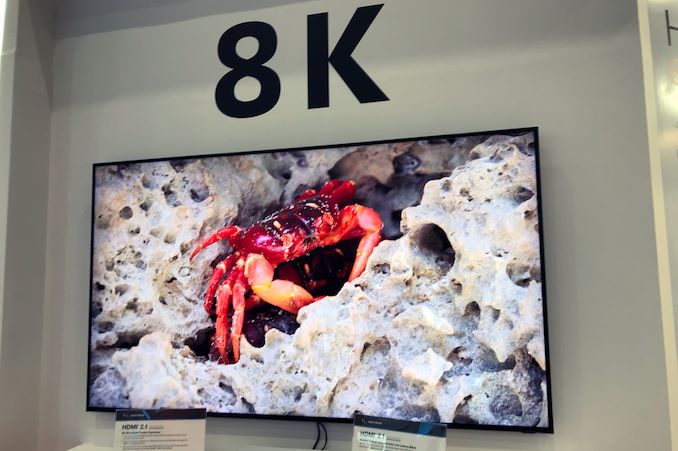

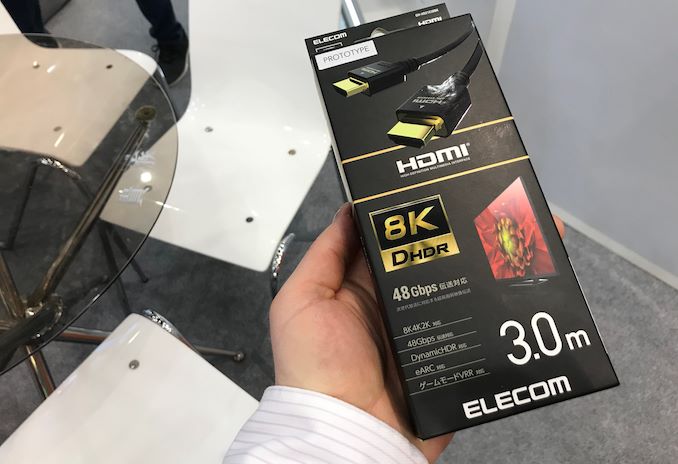
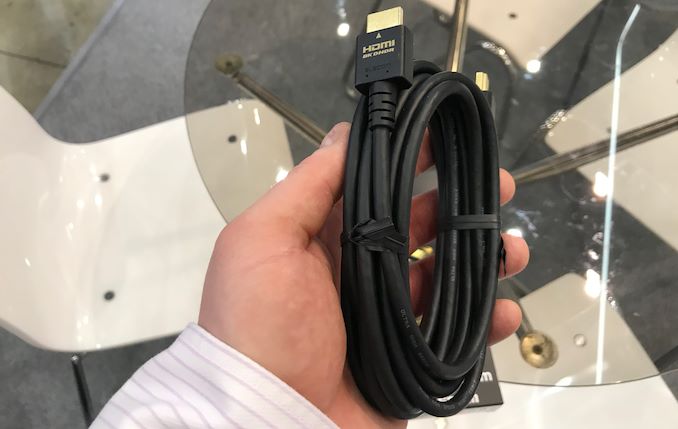

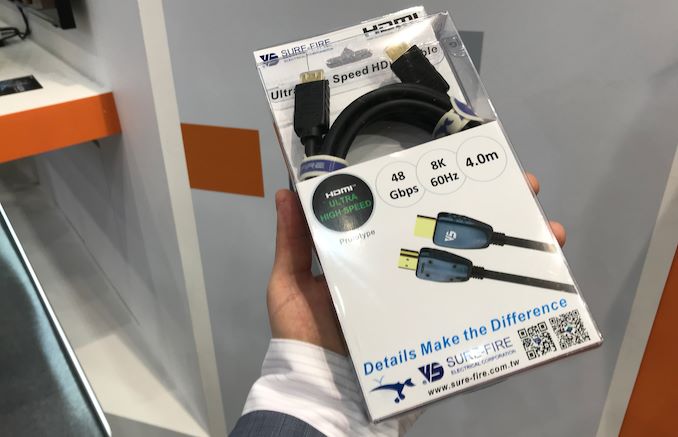








24 Comments
View All Comments
TheUnhandledException - Thursday, June 13, 2019 - link
Exactly. Hell 1080p@120 would be amazing for sports. However higher resolution is easier to market so everything is sacrificed at the altar of resolution.PVG - Thursday, June 13, 2019 - link
If only the networks focused on offering 1080p streams that are not over compressed garbage (let alone 4K ones) instead of this 8K nonsense."I need to see the olympics in 8K" said no one, ever.
"I'd like to see what's going on in the black and brown smeers" said A LOT of people, , on S8 E3 of Game of Thrones (as an example)...
BinaryTB - Thursday, June 13, 2019 - link
Xbox Scarlet launching Holiday 2020 will be better with 4k@120 + Variable Refresh Rate. Broadcasting or media sources may or may not be widely available, but gaming higher than 60hz with VRR is a game changer in the living room. It's one of those "can't go back to 60hz" type of scenarios that has happened in the desktop gaming space.Skeptical123 - Thursday, June 13, 2019 - link
I wish VESA would add a requirement for labeling HDMI cables indicating what generation a HDMI cable is.repoman27 - Thursday, June 13, 2019 - link
The HDMI Licensing Authority controls the HDMI specification, not VESA, and the requirement is to label HDMI cables according to the subset of features they support: https://www.hdmi.org/consumer/finding_right_cable....And to quote another page ( https://www.hdmi.org/consumer/buying_guide.aspx ) from the HDMI LA website:
"Shop for Features, not HDMI Versions
Some people have the mistaken idea that they should be shopping for a particular version of the HDMI Specification, for example, HDMI 2.0 or HDMI 1.4. This has never been true. Instead, you should shop for the specific features you want, and make sure that those features are supported in all the HDMI devices you will be using."
Wait, this sounds just like what the USB-IF said about USB Specification version numbers...
Skeptical123 - Thursday, June 13, 2019 - link
Rip thanks for pointing that out I forgot it's not all centralized/standardized. I guess I was thinking wishfully when I wrote that... I realized my mistake after hitting enter but there is no way to edit or delete comments unfortunately.Also that quote is cringe. There are so many "features" 10k 2hz 20bit but that is does not make since to list them since bandwidth/generation is the only useful thing. My point still stands though. Unless I label the cable as soon as I get it the only way to know if a HDMI cable is going to work is by trial and error. For the "norms" with one or two HDMI cables this is not as much of an issue but it's still horrible design imo. Also I assume that requirement for labeling is just for the packaging and not the cable. Or it's not strictly enforced because this is a common issue I run into and see other people dealing with too at work.
repoman27 - Thursday, June 13, 2019 - link
I just spot checked a few cables I have lying around from 3 different manufacturers and they're all labeled "High-Speed HDMI Cable with Ethernet". I'm guessing the older "Standard" cables just say "HDMI" on them. But as far as cables go, there really aren't many features to consider besides the maximum supported signaling rate. I mean, I've never seen anything that leveraged the HDMI Ethernet Channel or personally needed an HDMI cable for my car.That being said, I'm guessing most of those cables with braided jackets probably don't have any visible markings, do they? Unless it's stamped on the connector somewhere. Also, I did spring for some "Premium" cables, and there was an actual difference. Now I can drive my 4K UHD TV @ 60 Hz from my PC over a 15 foot cable, whereas I wasn't able to go longer than 6 feet with my not-so-premium High Speed cables. The "Premium" bit was only on the packaging though, not on the cables themselves, but fortunately they're pretty easy to distinguish by their heft.